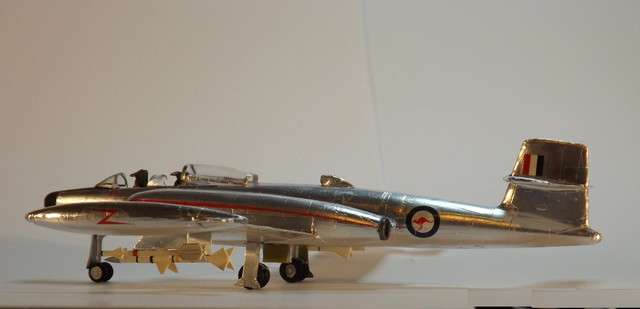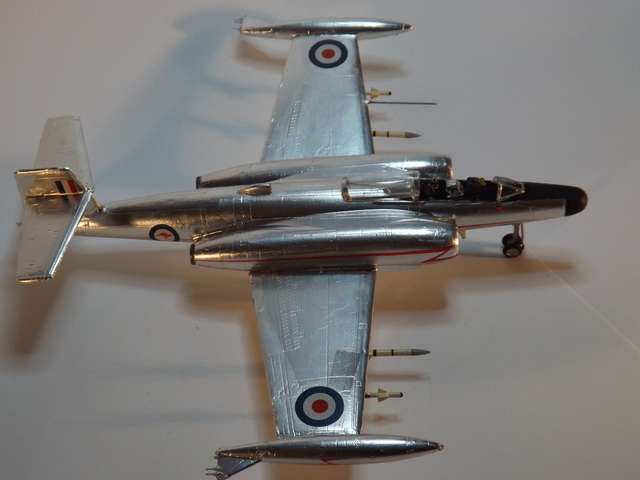The Avro Canada CF-100 Canuck in RAAF ServiceWhen the RAAF entered the Korean War in 1950, it was very obvious that it's F-51
Mustangs were very much behind the curve of moden aeronautical developments. The USAF was already fielding large numbers of jet aircraft, the F-80
Shooting Star, the F-84
Thunderstreak and the soon to be introduced F-86
Sabre. The Communists were quick to introduce their latest aircraft in the MiG-15, which completely outclassed the RAAF's piston-engined aircraft. Hurriedly, the RAAF ordered Gloster
Meteors from the UK, having already had limited experience with the type, just after WWII when in 1946 a
Meteor captured Australian newspaper headlines when it flew over Melbourne at 788 km/h (490 mph). Imported on 7 June 1946, this
Meteor F 4 carried out trials at Laverton and Darwin and, at one time, carried two identification numbers - the RAF serial EE427 and the RAAF allocation A77-1. However, it was not until 1951, when
Meteors went into action with No 77 Squadron in Korea, that these aircraft made their mark in RAAF history.
Ninety-three
Meteor F 8s and six
Meteor T 7s were allocated to the Korean War with scattered serial numbers ranging between A77-2 (T 7) and A77-982 (F

. They were used mainly in the ground-attack role, but also accounted for three MIG-15s. Forty-one F 8s and three T 7s returned to Australia aboard HMAS Vengeance, and continued on in service with the RAAF, as second-line fighters until 1963. The
Meteor was an excellent introductory aircraft to jet propulsion, however as was discovered when facing the far faster and more manoeuvrable, swept-wing fighters it had severe limitations.
Another was that the
Meteor was purely a clear weather fighter, with no radar. The RAAF found this limited it's usefulness, particularly in the wintery skies above Korea. So, it began a search for an all-weather fighter compliment to it. Internationally, there were several alternatives available - a variant of the
Meteor (based on the T.7), the F-89 Scorpion and the Canadian CF-100
Canuck. However, due to the massive re-equipment of the RAF and USAF as a consequence of the Korean War emergency, neither the UK or the US would be in a position to fulfil any orders from the RAAF for several years. When the performance characteristics of the three contenders were compared and confirmed by an investigating commission sent overseas to test the aircraft, the CF-100 was a clear winner, particularly when it was able to demonstrate that it could break the sound barrier in a dive. Avro Canada, manufacturers of the CF-100 were quite willing to negotiate a license production agreement with Australia.
The Australian Government Aircraft Factories started licensed production of 50 CF-100
Canuck aircraft in 1953 (48 fighters and 2 TF-100 trainers). Entering service with the RAAF serial A82, they were issued to Nos 21,22 and 23 Squadrons. During their service lives from 1954 to 1966, the CF-100s were steadily upgraded from Mk.3 to Mk.5 standard, with the main changes being to electronic equipment and eventually armament. Unlike Canadian and Belgian versions, the RAAFs were armed to carry 4 x 30mm ADEN cannon instead of the standard 8 x .50in machineguns, an armament they retained throughout their careers. In 1960, while waiting their replacement, they were finally upgraded to operate air-to-air missiles (2 x AIM-7C Sparrow and 2 x AIM-9B Sidewinder). Their advanced, for the day, radars and air intercept systems allowed them to find and destroy targets in all weathers and times of day, an advantage particularly in the tropical storms experienced in and around Darwin and far North Queensland when the main day fighter for the period, the CA-27 Avon Sabre lacked any radar.
The aircraft depicted is that of A82-5, serving with 21 Squadron, Richmond, in 1960. Unusually, this aircraft does not carry it's serials, which in the various pictures of it has never been fully explained.





 The Model
The ModelThis is the venerable Hobbycraft CF-100 Mk.4, in 1/72 scale. It is constructed as standard, except for the addition of four underwing hardpoints and the missiles they carry. I experimented on this model with Baremetal Foil. As a consequence, I've learnt a lot and will more than likely continue to use it (or plain Aluminium foil) in future for bare metal finishes. I'm pleased with the results. Much better than anything I've achieved from a tin of paint.